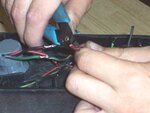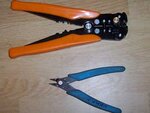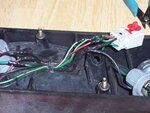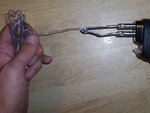How to Solder
In these photos I'm changing the plug connector and replacing a missing bulb socket on a taillight I got at the junkyard. That's not the point though. The point here is to show you guys how to solder. I see a lot of crap wiring out there. It's scary, it's just bad and there's no reason for it. Soldering doesn't require any expensive equipment or any great skill. It takes less than $50 for tools and supplies and maybe a couple hours practice.
Tools Required:
*100 Watt soldering "gun" from Sears or Radio Shack $30
**wire stripper from Harbor Freight $10
Supplies
spool of .032 solder
electric "black" tape
***spool of 18 gauge stranded wire
inline fuse holder (depending on what you're trying to make)
split loom aka corrugated tubing
small zip ties
*Don't get that "cold solder" crap. The name itself is reason enough. A "cold" solder is a bad solder joint. Don't get a low wattage pencil shaped soldering iron (unless its a butane iron). Get yourself a Craftsman 100/140 watt gun shaped soldering iron with the little light on the end (or similar). The quality of the soldering iron and solder will determine the quality of the job and whether you ever learn to solder successfully.
**The quick strip tools are the most desirable (orange handles), however, I often rely on my little cutting tool (blue handles). I got this from the Snap On guy, although it is not made by Snap On. If you use this tool, squeeze the wire until you feel the tool bite into the insulation, then push the tool upward with the thumb on the same hand that is bracing the wire (see photo). I recommend against the most common type of wire strippers.
*** 18 gauge works for most things we do to our cars, but use your own discretion. Starter/alternator wires are 10 gauge. If you want to upgrade your ignition/fuel/lighting wiring you might want to use 16 gauge, but no thicker than 14 gauge.
Steps:
Wash your hands. You want to reduce the amount of human contaminants in the joint to prevent corrosion.
Strip back the insulation on each of the wires half an inch. Twist the wires together. Don't use the traditional method of twisting them together. You want the twist inline with the wire. Make sure there are no points sticking up. Roll the wires together like a joint (pun intended). Hey, this is how I was taught, okay?!
Heat up the soldering gun and then touch the solder to the tip and get a thin layer of solder at the point. Lay the twisted portion of the wires on top of the soldering point, and then wait a few seconds for the wire to heat up. Touch the solder to the wire strands (not the soldering gun). You'll notice that the wire itself liquifies the solder and it soaks between the strands. You want to lightly paint the entire joint this way. The strands need to remain visible. You don't want a big goober on top of the wire. Less is more. Don't overheat the joint. If the insulation starts to boil off the wires, you're overheating it. Work faster.
Wrap the joints in electric tape. Electric tape is the only tape that will work. Stretch the tape slightly when wrapping it up. Squeeze the joint between your fingers to make sure a strand isn't poking through. In most cases you'll want to bundle your wires with tape or split loom, then secure them with zip ties.
Now get out there and redo all your shitty wiring. Then, once you have some practice under your belt, go out and make some money building harnesses and doing conversions for people.
Attachments
-
 solder.jpg12.7 KB · Views: 1,927
solder.jpg12.7 KB · Views: 1,927 -
 solder2.jpg11.8 KB · Views: 1,903
solder2.jpg11.8 KB · Views: 1,903 -
 solder3.jpg11.1 KB · Views: 1,821
solder3.jpg11.1 KB · Views: 1,821 -
 solderGun.jpg8.3 KB · Views: 2,804
solderGun.jpg8.3 KB · Views: 2,804 -
 strip.jpg8.9 KB · Views: 1,892
strip.jpg8.9 KB · Views: 1,892 -
 strippers.jpg9.9 KB · Views: 1,890
strippers.jpg9.9 KB · Views: 1,890 -
 supplies.jpg9.2 KB · Views: 1,891
supplies.jpg9.2 KB · Views: 1,891 -
 tape.jpg13.3 KB · Views: 1,808
tape.jpg13.3 KB · Views: 1,808 -
 tin.jpg8.1 KB · Views: 1,810
tin.jpg8.1 KB · Views: 1,810 -
 twist.jpg9.7 KB · Views: 1,868
twist.jpg9.7 KB · Views: 1,868
Last edited by a moderator:
